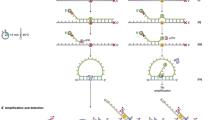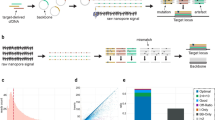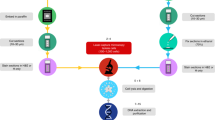Abstract
The sensitivity of conventional DNA sequencing in tumor biopsies is limited by stromal contamination and by genetic heterogeneity within the cancer. Here, we show that microreactor-based pyrosequencing can detect rare cancer-associated sequence variations by independent and parallel sampling of multiple representatives of a given DNA fragment. This technology can thereby facilitate accurate molecular diagnosis of heterogeneous cancer specimens and enable patient selection for targeted cancer therapies. NOTE: In the version of this article initially published, it should have been acknowledged that Jan F. Simons, in addition to Roman K. Thomas and Elizabeth Nickerson, contributed equally to this work. The error has been corrected in the HTML and PDF versions of the article.
This is a preview of subscription content, access via your institution
Access options
Subscribe to this journal
Receive 12 print issues and online access
$209.00 per year
only $17.42 per issue
Buy this article
- Purchase on Springer Link
- Instant access to full article PDF
Prices may be subject to local taxes which are calculated during checkout


Similar content being viewed by others
Change history
13 September 2006
In the version of this article initially published, it should have been acknowledged that Jan F. Simons, in addition to Roman K. Thomas and Elizabeth Nickerson, contributed equally to this work. The error has been corrected in the HTML and PDF versions of the article.
References
Sawyers, C. Targeted cancer therapy. Nature 432, 294–297 (2004).
Heinrich, M.C. et al. Kinase mutations and imatinib response in patients with metastatic gastrointestinal stromal tumor. J. Clin. Oncol. 21, 4342–4349 (2003).
Shah, N.P. et al. Multiple BCR-ABL kinase domain mutations confer polyclonal resistance to the tyrosine kinase inhibitor imatinib (STI571) in chronic phase and blast crisis chronic myeloid leukemia. Cancer Cell 2, 117–125 (2002).
Paez, J.G. et al. EGFR mutations in lung cancer: correlation with clinical response to gefitinib therapy. Science 304, 1497–1500 (2004).
Pao, W. et al. EGF receptor gene mutations are common in lung cancers from “never smokers” and are associated with sensitivity of tumors to gefitinib and erlotinib. Proc. Natl. Acad. Sci. USA 101, 13306–13311 (2004).
Lynch, T.J. et al. Activating mutations in the epidermal growth factor receptor underlying responsiveness of non-small-cell lung cancer to gefitinib. N. Engl. J. Med. 350, 2129–2139 (2004).
Pao, W. et al. Acquired resistance of lung adenocarcinomas to gefitinib or erlotinib is associated with a second mutation in the EGFR kinase domain. PLoS Med. 2, e73 (2005).
Kobayashi, S. et al. EGFR mutation and resistance of non-small-cell lung cancer to gefitinib. N. Engl. J. Med. 352, 786–792 (2005).
Shah, N.P. et al. Overriding imatinib resistance with a novel ABL kinase inhibitor. Science 305, 399–401 (2004).
Kwak, E.L. et al. Irreversible inhibitors of the EGF receptor may circumvent acquired resistance to gefitinib. Proc. Natl. Acad. Sci. USA 102, 7665–7670 (2005).
Sanger, F., Nicklen, S. & Coulson, A.R. DNA sequencing with chain-terminating inhibitors. Proc. Natl. Acad. Sci. USA 74, 5463–5467 (1977).
van Ommen, G.J., Bakker, E. & den Dunnen, J.T. The human genome project and the future of diagnostics, treatment, and prevention. Lancet 354 Suppl 1, SI5–10 (1999).
Ronaghi, M., Uhlen, M. & Nyren, P. A sequencing method based on real-time pyrophosphate. Science 281, 363–365 (1998).
Margulies, M. et al. Genome sequencing in microfabricated high-density picolitre reactors. Nature 437, 376–380 (2005).
Janne, P.A. et al. A rapid and sensitive enzymatic method for epidermal growth factor receptor mutation screening. Clin. Cancer Res. 12, 751–758 (2006).
Tsao, M.S. et al. Erlotinib in lung cancer - molecular and clinical predictors of outcome. N. Engl. J. Med. 353, 133–144 (2005).
Bell, D.W. et al. Epidermal growth factor receptor mutations and gene amplification in non-small-cell lung cancer: molecular analysis of the IDEAL/INTACT gefitinib trials. J. Clin. Oncol. 23, 8081–8092 (2005).
Cortes-Funes, H. et al. Epidermal growth factor receptor activating mutations in Spanish gefitinib-treated non-small-cell lung cancer patients. Ann. Oncol. 16, 1081–1086 (2005).
Greulich, H. et al. Oncogenic transformation by inhibitor-sensitive and -resistant EGFR mutants. PLoS Med. 2, e313 (2005).
Acknowledgements
This work was supported by the Deutsche Krebshilfe through a Mildred-Scheel Fellowship for Cancer Research to R.K.T. W.R.S. and M.M. are supported by the Novartis Research Foundation, the Claudia Adams Barr Foundation and the Charles A. Dana Human Cancer Genetics Program of the Dana-Farber Cancer Institute, the Poduska Family Foundation, the Damon-Runyon Cancer Research Foundation, Joan's Legacy, the American Cancer Society (RSG-03-240-01-MGO), the Flight Attendant Medical Research Institute and the US National Cancer Institute (R01CA098185). We are greatly indebted to J. Prensner and J. Baldwin for comments and advice.
Author information
Authors and Affiliations
Contributions
R.K.T., E.N., J.F.S., M.E., W.R.S., J.M.R. and M.M. designed the research. R.K.T, E.N., J.F.S., T.T., Y.Y., T.L., J.C.L., K.S., K.O'N., R.D., T.-H.C., K.A.G., H.G., B.D., C.K.L., W.B., P.A., S.K.H., J.H.L., M.T.R. and G.S.T. performed research and analyzed data. P.A.J., H.S., N.L., K.-K.W., A.M.B., E.J.G. and K.H.D. provided samples and patient information. R.K.T., E.N., J.F.S., L.A.G., M.E., W.R.S. and M.M. wrote the manuscript.
Corresponding author
Ethics declarations
Competing interests
Matthew Meyerson and William R. Sellers have received funding from and served as consultants for Novartis, where Dr. Sellers is now employed.
Matthew Meyerson has received research funding from Genentech.
Jan F. Simons, Brian Desany, Christine K. Lubeski, Stephen K. Hutchinson, J.H. Leamon, Michael T. Ronan, Gregory S. Turenchalk, Michael Egholm and Jonathan M. Rothberg are employees of 454 Life Sciences.
Elisabeth Nickerson was an employee of 454 Life Sciences at the time the research was conducted; she is now an employee of Helicos BioSciences.
Matthew Meyerson, Pasi A. Jänne and William R. Sellers are inventors on a patent application for EGFR mutation detection as a diagnostic tool in cancer.
Supplementary information
Supplementary Fig. 1
Schema of experimental approach for PCR-based exon resequencing. (PDF 77 kb)
Supplementary Fig. 2
Power as a function of number of reads for various concentrations of mutations in the sample. (PDF 37 kb)
Supplementary Fig. 3
Serial dilution of amplicons containing a single-base substitution or a 12-bp deletion into the corresponding wild-type backgrounds, followed by high-coverage sequencing or low-level mutation detection. (PDF 54 kb)
Supplementary Fig. 4
Picotiter plate sequencing of samples S0373 and S0331. (PDF 373 kb)
Supplementary Fig. 5
Oncogenic transformation by patient-derived EGFR mutations and differential sensitivity of Del-4 with and without T790M mutation. (PDF 77 kb)
Supplementary Fig. 6
Validation of mutations detected by picotiter plate sequencing using extensive cloning and sequencing. (PDF 67 kb)
Supplementary Fig. 7
Picotiter plate sequencing of a paraffin-embedded pleural effusion sample obtained before onset of therapy from patient 12.3. (PDF 510 kb)
Supplementary Table 1
Mutations detected by picotiter sequencing. (PDF 8 kb)
Rights and permissions
About this article
Cite this article
Thomas, R., Nickerson, E., Simons, J. et al. Sensitive mutation detection in heterogeneous cancer specimens by massively parallel picoliter reactor sequencing. Nat Med 12, 852–855 (2006). https://doi.org/10.1038/nm1437
Received:
Accepted:
Published:
Issue Date:
DOI: https://doi.org/10.1038/nm1437



